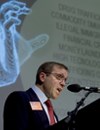WADA releases new Donati-report on trafficking of doping substances

26.03.2007
By Marie V. ThesbjergA worldwide research study, undertaken by anti-doping expert Sandro Donati for the World Anti-Doping Agency (WADA) in February 2007, assembles information and data that estimates the total volume of traffic of doping substances in the world.
Donati estimates that there are 31 million users worldwide. This is based on calculations from twenty countries in which the seizures of doping substances have been studied. Those twenty countries alone count for 15.5 million users.
The millions of people involved in doping are athletes of various levels, body builders and other gym-goers, people in the military and various types of police officer, bodyguards and private surveillance agents, people involved in show business, and victims of the improper administration of drugs.
The anti-doping movement faces a number of challenges: the absence of national laws in many countries and the failure to enforce existing laws in others, as well as the dearth of reliable information to accurately describe the problem and develop solutions.
Danger to society
The report also points out that medical expenditure to cure pathologies caused by drugs and doping now is higher than the entire illegal business of these drugs.
In the USA, for example, it is estimated that an annual medical expenditure of almost 100 billion dollars was needed to treat the problems of drug addicts, whose drug expenditure amounted to 65 billion dollars.
It is yet another danger to society in addition to the problems of trafficking outlined in Donati’s study.
The report outlines the main trafficking routes, and the resulting picture is alarming to the international community, particularly to those governments that have yet to commit to outlawing the manufacture, supply and possession of doping substances.
“This type of pharmaceutical industry poses a threat to society and for some time now it has been the ideal partner of organized crime. What better agreement could, indeed, be imagined than that established between this kind of pharmaceutical industry and organised crime? The former has the need, once an excess of drugs has been produced (in relation to the real treatment needs of sick people), to sell them, keeping itself as far from suspicion as possible, whilst organised crime networks can obtain unofficial drugs that can be managed with great ease and to great financial advantage,” the report argues.
Download the report:World Traffic in Doping Substances (external link, opens in new window)
More information on Sandro Donati





